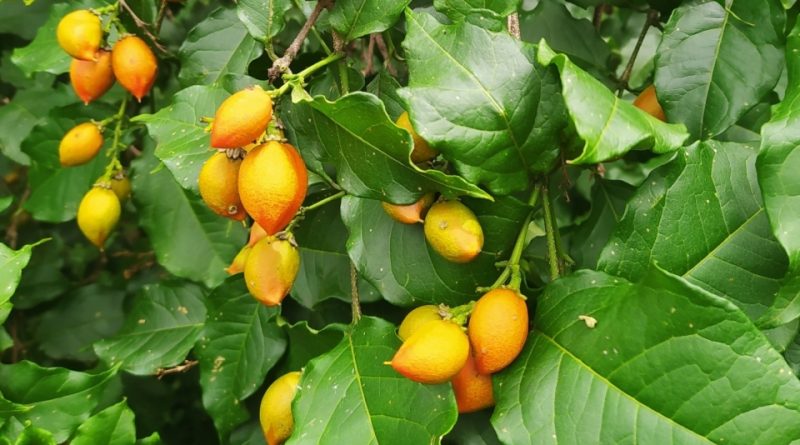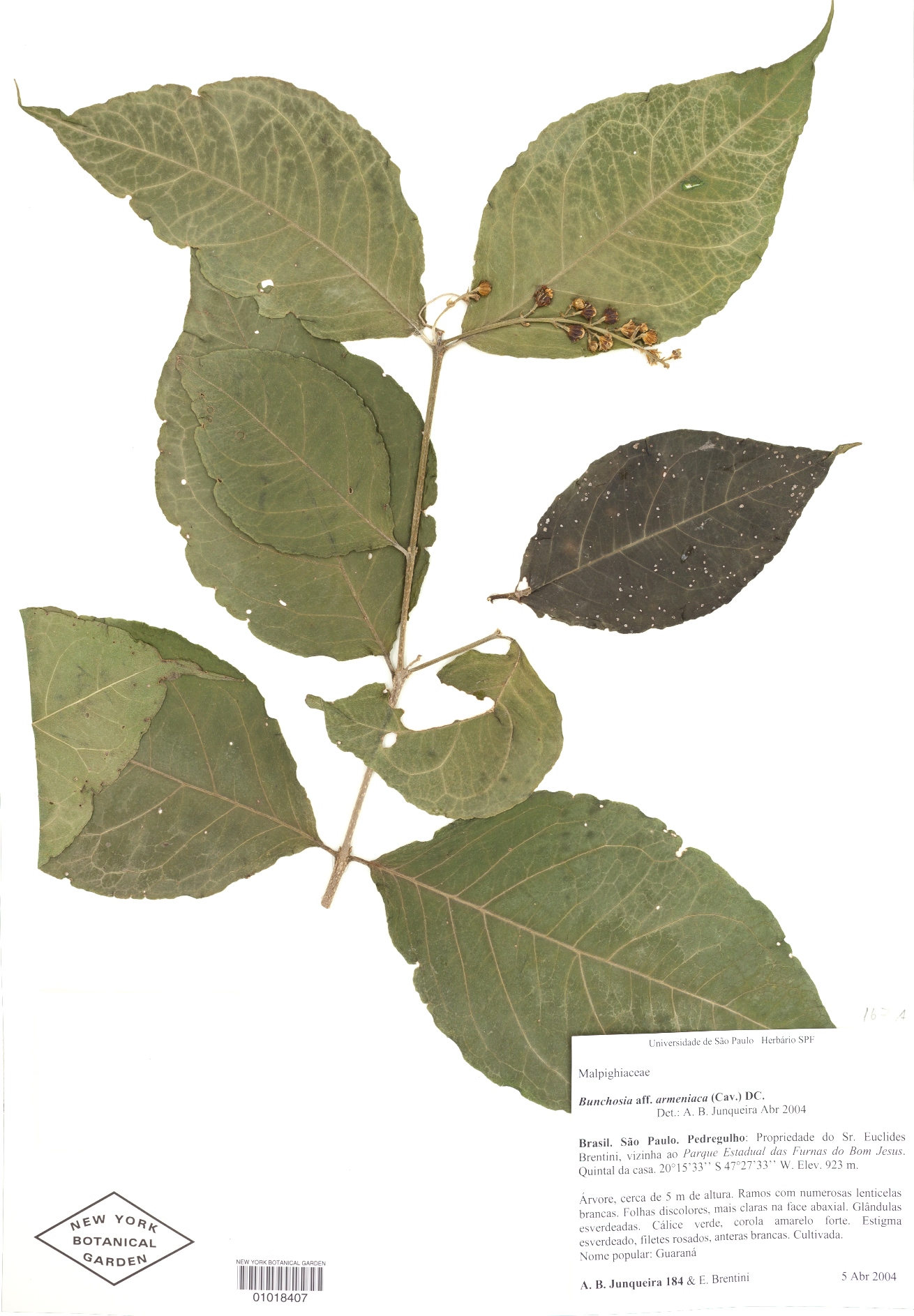Bunchosia armeniaca
Bunchosia armeniaca
The monk’s plum or peanut butter tree, peruvian plume (Bunchosia armeniaca (Cav.) DC., 1824) is an arboreal species belonging to the Malpighiaceae family.
Systematics –
From a systematic point of view it belongs to:
Eukaryota domain,
Kingdom Plantae,
Magnoliophyta division,
Rosidi class,
Malpighiales Order,
Malpighiaceae family,
Genus Bunchosia,
Species B. armeniaca.
The terms are synonyms:
– Malpighia armeniaca Cav. (1789);
– Bunchosia pilocarpa Rusby (1907);
– Bunchosia armeniaca f. parvifolia Nied. (1914);
– Bunchosia armeniaca f. systyla Nied. (1914).
Etymology –
The term Bunchosia derives from the Arabic name buncho given to the coffee plant due to the similarity of the seeds; the suffix -osia could be derived from the ancient Greek -osis or from the Latin -osus, both indicating abundance or fullness. Hence, Bunchosia could refer to plants that produce abundant fruit or flowers.
The specific armeniaca epithet refers to the similarity of the shape and color of the fruits, similar to those of apricots (Prunus armeniaca L.).
Geographic Distribution and Habitat –
Bunchosia armeniaca is a plant native to north-western South America: (Colombia, Ecuador, Bolivia, Venezuela, Brazil and Peru).
Its natural habitat is that of the humid tropical forests of the Amazon, where it thrives in areas with a hot and humid climate. The plant is adapted to these conditions and grows best in well-drained soils rich in organic matter, where it grows at altitudes between 1,500 and 2,400 metres.
Description –
Bunchosia armeniaca is a plant that grows in the form of an evergreen shrub or tree which in nature can reach 20 m in height while in cultivation it reaches up to 10 meters in height.
The trunk and adult branches have a greyish bark.
The leaves are carried by an about 1 cm long petiole; they are opposite, simple, ovate-oblong in shape, coriaceous, with pointed apex and wavy margin, 10-20 cm long and 4-8 cm broad.
The inflorescences are of the racemose type, compact axillary, 8-15 cm long; they carry numerous yellow hermaphroditic flowers, on a 0,5-1 cm long pedicel provided with glandular tubercles, of about 1,5 cm of diameter. The calyx is five-part, with 5 unguiculate petals, 5-6 mm long, with ovate lamina and fringed-toothed margin, and 10 monadelphic stamens.
The fruits are ovoid drupes with a color that varies from orange to red when ripe; they have a length of 2.5-4 cm.
Inside the fruits there are 1-2 seeds immersed in a red-orange pulp.
Cultivation –
Bunchosia armeniaca is an evergreen shrub or small tree that, outside its natural habitat, was already cultivated, mainly in gardens for its edible fruit, in parts of Ecuador since before Europeans arrived in South America.
The fruits are sold in local markets.
This plant grows at low to medium altitude in the tropics and is quite cold hardy, but is damaged in temperatures of -2°C in countries such as Florida.
It grows in most soils in a sunny position and, under certain conditions, these plants escape cultivation and become naturalized.
The substrate should be slightly acidic to slightly alkaline, kept moist. Where the climate does not allow the continuous permanence in open air, it can be cultivated in capacious containers to be sheltered during the coldest months in a luminous location with minimum values of temperature not under the 15 °C.
It is to be watered frequently in summer, thinning out in winter, but without ever allowing the substratum to dry up completely and the fertilizations, in spring, done with a slow release product.
Plants can start producing fruit in as little as two years from seed.
Trees can flower and bear fruit most of the year in appropriate climates: usually several crops of fruit are produced each year.
The plant usually reproduces by seed, which does not have a long germination period; the seed is to be placed in a draining substratum, kept humid, but without stagnations, at a temperature of 24-26 °C; under these conditions, germination takes 1-2 months and the first fructification starts from the second-third year of age.
Customs and Traditions –
Bunchosia armeniaca is known by various names, including: monk’s plum, peanut butter tree, peruvian plume (English); bunchosie abricot, bunchosie des andes, cerise des Antilles (French); ameixa-brava, ameixa-do-Peru, caferana, cafezinho, ciruela, false guaraná (Portuguese from Brazil); chico mamey, ciruela de fraile, ciruela silvestre, ciruela verde (Spanish).
this plant is cultivated both for its fruits and for its ornamental aspect.
The fruits have a creamy and sweet pulp with a flavor reminiscent of peanuts; these are locally eaten fresh or used for jellies, jams and to flavor dishes.
In the areas of origin, the fruits of this plant, called achacha, are particularly appreciated for their sweet-acidic taste and their high vitamin C content.
In recent years, achacha has also become more popular in other parts of the world as an exotic fruit, and has been introduced to some subtropical and tropical regions where climatic conditions are similar to those of the Amazon.
Parts of the plant are used in traditional medicine for various pathologies; laboratory studies have highlighted the presence in the extracts of the leaves of bioactive compounds with antibacterial and anti-inflammatory properties.
Among the other uses we mention, as mentioned, the ornamental ones as the plant is utilized for landscape uses in parks and gardens.
Method of Preparation –
Bunchosia armeniaca is a plant cultivated for both ornamental and edible uses.
In the food sector, both raw and cooked fruits are eaten. The flesh is sweet but thin and rather dry.
They are usually eaten fresh and are also made into preserves.
Some parts of the plant are used in traditional medicine by local populations.
Guido Bissanti
Sources
– Acta Plantarum – Flora of the Italian Regions.
– Wikipedia, the free encyclopedia.
– GBIF, the Global Biodiversity Information Facility.
– Useful Tropical Plants Database.
– Conti F., Abbate G., Alessandrini A., Blasi C. (ed.), 2005. An annotated checklist of the Italian vascular flora, Palombi Editore.
– Pignatti S., 1982. Flora of Italy, Edagricole, Bologna.
– Treben M., 2000. Health from the Lord’s Pharmacy, Advice and experiences with medicinal herbs, Ennsthaler Editore.
Photo source:
– https://www.inaturalist.org/observations/68224352
– https://sweetgum.nybg.org/images3/1445/188/01018407.jpg
Attention: The pharmaceutical applications and alimurgical uses are indicated for informational purposes only, they do not in any way represent a medical prescription; we therefore decline all responsibility for their use for curative, aesthetic or food purposes.


